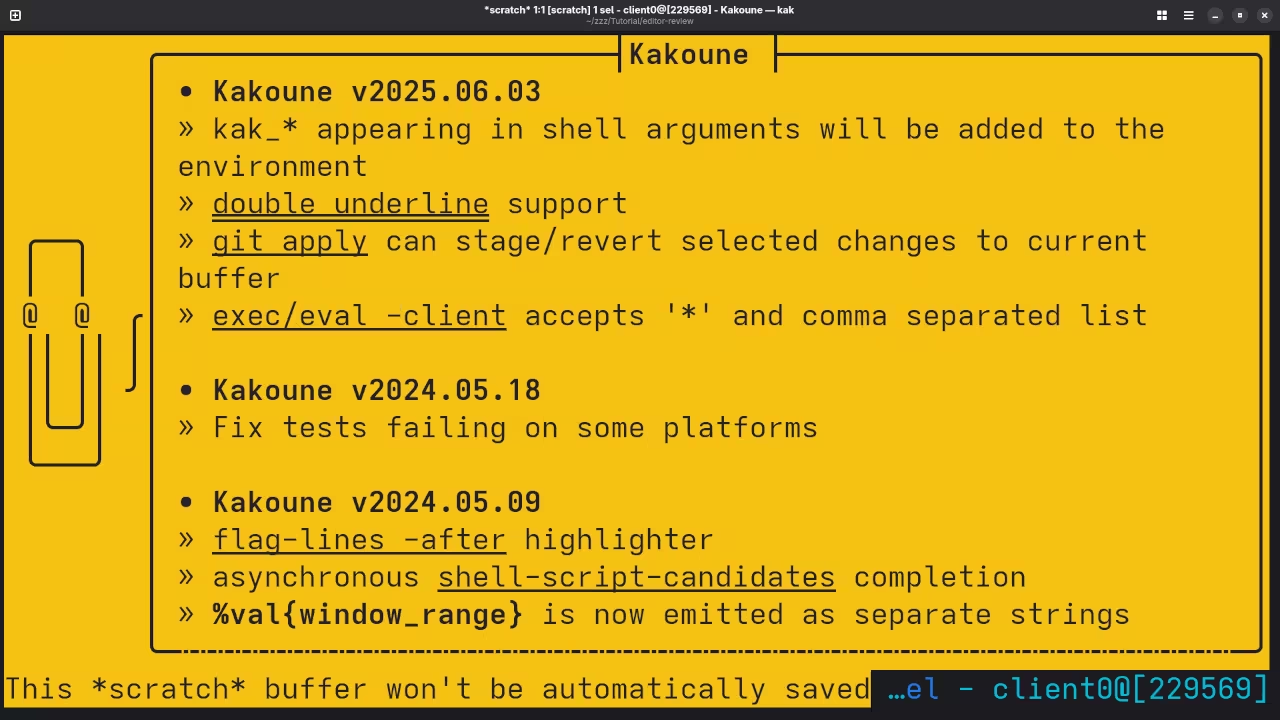Kakoune: A Beginner’s Look at the Open Source, Interactive Code Editor
Are you on the hunt for a text editor that’s as efficient as it is interactive? Meet Kakoune, a modern and powerful modal code editor that takes inspiration from the classic Vi/Vim but flips the editing model to enhance your workflow. It’s a fantastic tool for developers and anyone who spends a lot of time writing or manipulating text!
What Makes Kakoune Stand Out?
Kakoune is built around a philosophy of interactivity and multiple selections. Instead of operating in the traditional ‘verb-object’ style (like ‘delete word’), Kakoune uses an ‘object-verb’ model: select first, then act. This immediate feedback is a game-changer and makes editing highly intuitive.
- Multiple Selections: This is the core feature. You can select multiple, non-contiguous pieces of text simultaneously and apply an action to all of them at once. Imagine changing the name of a variable everywhere in a file with a single set of keystrokes!
- Contextual Help & Completion: Kakoune provides real-time information as you type commands, making it much easier for beginners to learn the system without constantly referring to documentation.
- Client-Server Architecture: This design allows multiple windows (clients) to connect to the same editing session (server), which is perfect for working in a terminal multiplexer like tmux or zellij.
Open Source and Licensing
One of the greatest things about Kakoune is that it is completely open source. Its source code is freely available for anyone to view, modify, and distribute.
- License: Kakoune is licensed under the Unlicense. The Unlicense essentially dedicates the work to the public domain, offering maximum freedom. It’s one of the most permissive licenses available, meaning you can pretty much do anything you want with the code.
How to Install Kakoune
Kakoune is available for most Unix-like systems. Installation is typically straightforward, often leveraging your distribution’s package manager.
Focus Platform: Fedora Linux
For users on Fedora Linux (or RHEL/CentOS 8+ via EPEL), the simplest way to install Kakoune is through the standard package manager, dnf:
sudo dnf install kakouneOther Popular Platforms
Here are installation methods for a few other common systems:
| Platform | Installation Command(s) |
|---|---|
| Debian/Ubuntu | sudo apt install kakoune |
| macOS (Homebrew) | brew install kakoune |
| Arch Linux | sudo pacman -S kakoune |
Once installed, you can start the editor by simply typing kak in your terminal:
kak my_new_file.txtScreenshots and Screencast
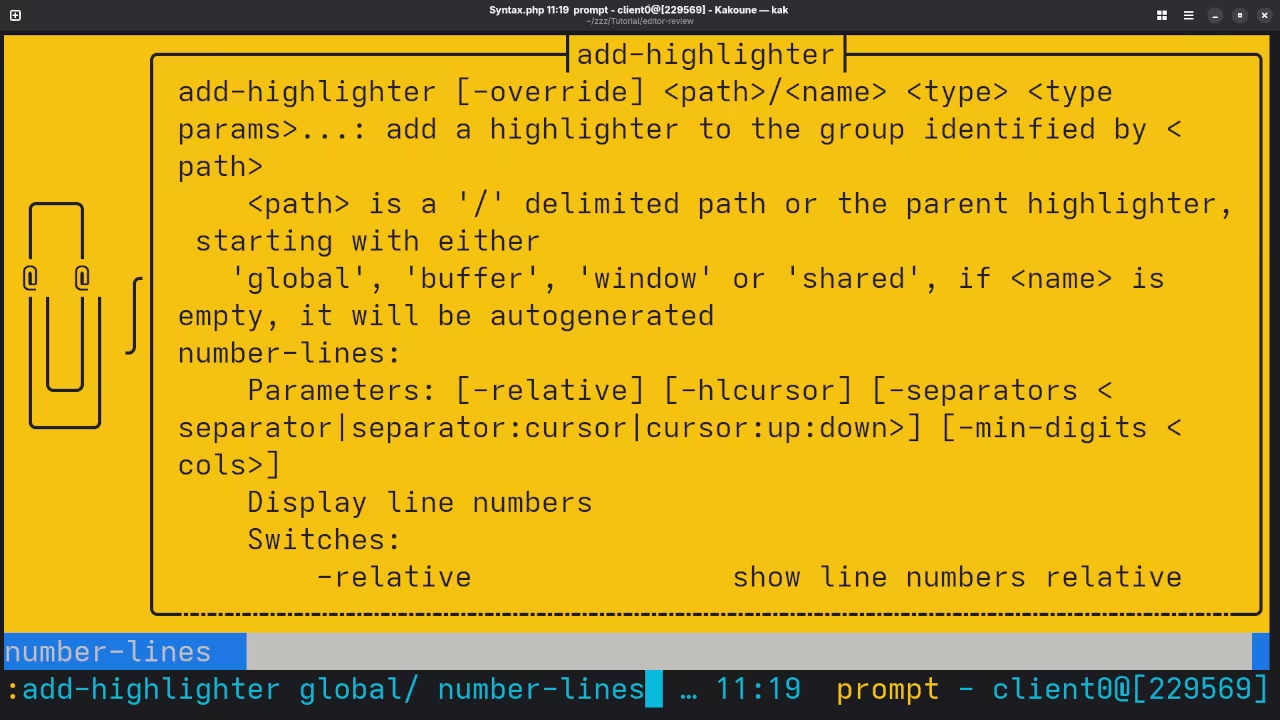
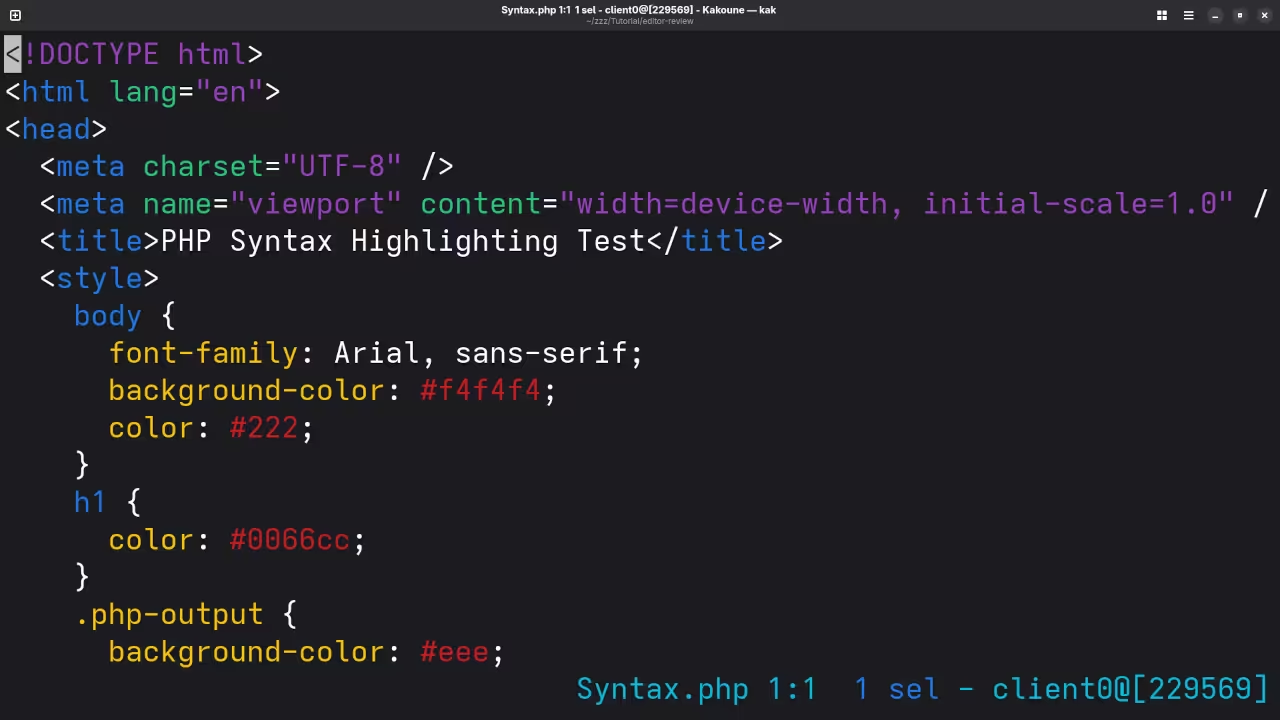
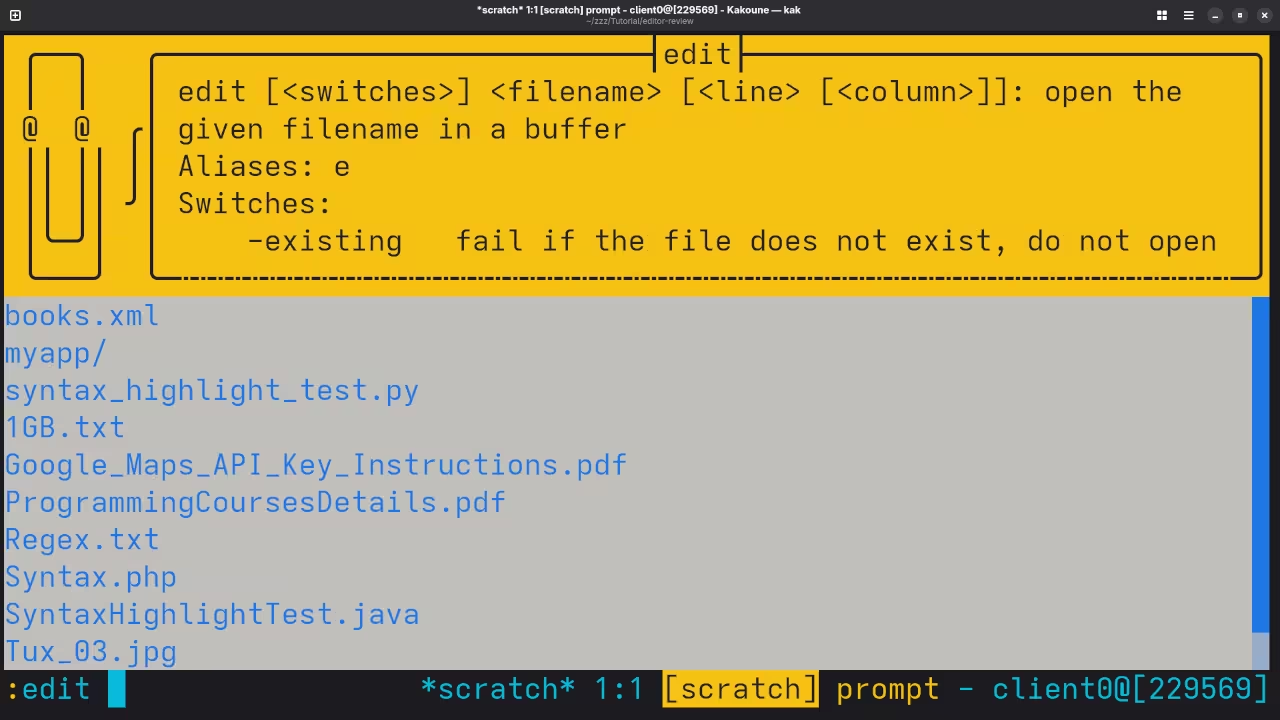
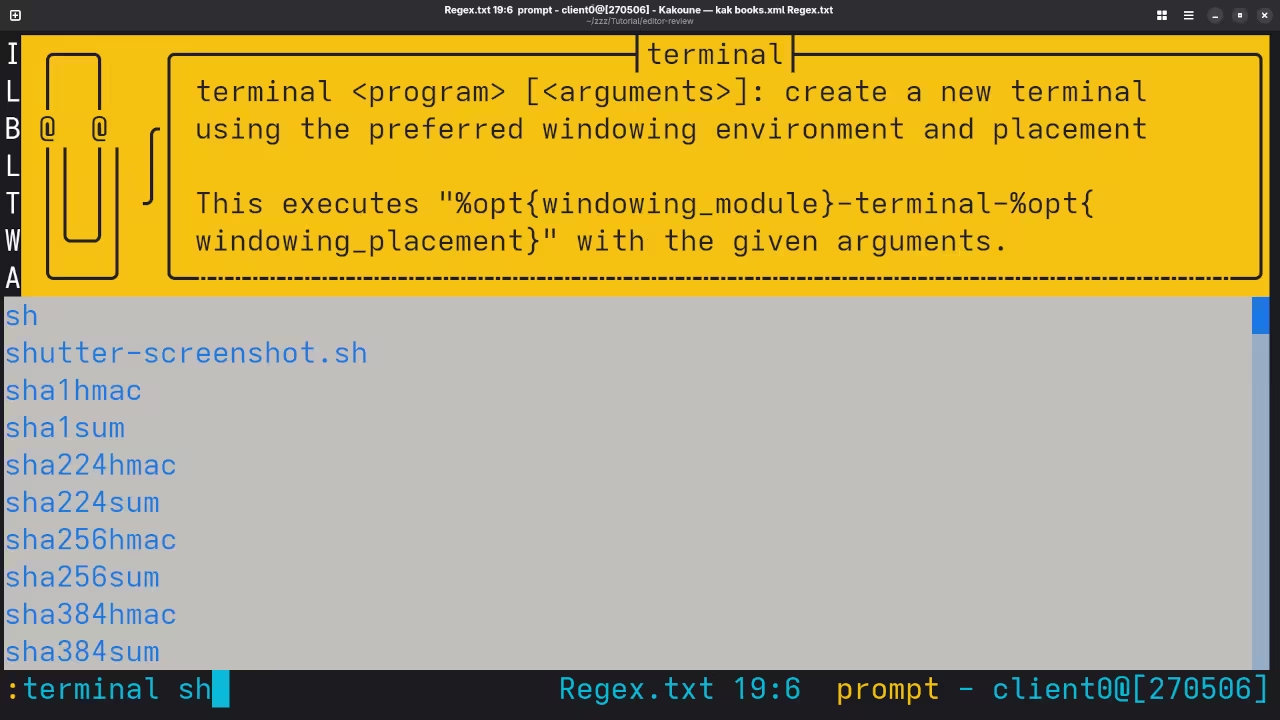
👉 Screencast showing a beginner session in Kakoune—editing, saving files, and navigating buffers.
Requirements For Programming Text Editor
Glossary:
Code Editor
Designed for writing and editing source code.
IDE
Integrated Development Environment combines various tools need for software development.
Plugin
Software component that adds specific functionality.
Theme
Preset package containing graphical appearance to customize look and feel.
Open source
Freely available for possible modification and redistribution.
SCM
Source code management use to manage and track modifications to a source code repository.
LMB
Left Mouse Button (LMB) or left click
MMB
Middle Mouse Button (MMB) or scroll wheel
Test Tools
| Name | Description |
|---|---|
| CPU | Ryzen 5 5600GT @ 3.60GHz. |
| Memory | 32GB DDR4. |
| Operating System | Fedora Linux Workstation 43. |
| Desktop Environment | Gnome 49. |
| Name | Description |
| Name | Description |
|---|---|
| Large File | 1GB human-readable text. |
| Regex File | Text with word “Kakoune” repeated. |
| Syntax File | PHP file containing HTML, CSS & JavaScript. |
| Media File | Smiley face or Tux Linux JPEG file. |
| Java Version | OpenJDK 21.0.9. |
| PHP Version | PHP 8.4.13. |
| Python Version | Python 3.14.0. |
| Kakoune Version | 2025.06.03 |
| Name | Description |
Test Scoring
- Each feature has two parts.
- Score of zero indicates a missing feature.
- A part of a feature is work a score of 0.5.
Three bias elimination steps were utilized. The editor was used for at least three years on different platforms. Attempts were made to get stable plug-ins for missing features. The same editor was compared between the one in the repository, the developers website, and the compiled version if applicable.
Selecting Editor Version
For this review, Kakoune was installed using the instructions from the developers website and it did not require additional plugins.
Features
- The theme can be native for the editor in terms of the background and toggled using
:colorscheme. Kakoune dark and light themes can be created or downloaded and changed. The score for the theme was a perfect 1.0. - Dragging and dropping a text file into the editor does not opens a new tab or buffer. It was not possible to specify the tab location during the drag and drop operation. The score for drag and drop into editor was 0.0.
- Opening a very large text file did not crash Kakoune. Kakoune was able to open or to edit the large file. The score for opening a large file was 1.0.
- Multiple documents can opened in multiple tabs or buffers. Tear-off tabs do not work and Kakoune does not have a feature to open in new window as a new instance which is handy for multiple monitors. The score for multiple documents was 0.5.
- Multiple editors can not be opened as new tabs with drag options. Each tab window view can not be split either vertically or horizontally as a multiple editor view in Wayland display server protocol. The score for multiple editor view was 0.0.
- Creating non-project files is possible. Non-project files can be opened on the command line. The score for creating non-project files was a perfect 1.0.
- Soft word wrap can be toggled by
:add-highlighter buffer/wrap wrap. Automatic soft wrap for documents is is available for Kakoune. The score for word wrap was 1.0. - Spell check can be enabled with
:spell enif aspell is installed, and works as words are typed. Spelling errors are shown in opened documents. The score for spell check was 1.0. - Word count can be achieved using word count (wc) as
%|wc -w<ret>for the entire buffer or|wc -w<ret>for selection. Word count for the current buffer or file worked. Selection word count is available as part of word count. The score for word count was 1.0. - Go to line can jump to a specified line using
gand entering the line number. It is possible to jump to either the first or last line. The score for go to line is a perfect 1.0. - Indentation can default to user-defined tab stops. Children are automatically indented. The score for indentation was a perfect 1.0.
- Fonts can be dynamically scaled with custom keyboard shortcuts
CTRL-MMB. The system font can be bypassed and a new editor font and size can be set. The score for fonts was a perfect 1.0. - Find and replace
%sWORDTOREPLACETthen press Enter thencREPLACEMENT, and also works when using regular expressions for all open documents in the current session. Find and replace will work for the current document or a selection in the current document. The score for find and replacing using regular expressions was a perfect 1.0. - Multiple language syntax highlighting in one file is enabled. Each language has code-sensitive syntax colours. The score for multiple language syntax highlighting was a perfect 1.0.
- Code folding does not work for markup languages such as HTML. Code folding also does not work for programming languages such as Java. The score for code folding was 0.0.
- Selecting rectangular block per column works holding the
SHIFT-Ckey. Rectangular block selection does not work properly with word wrap enabled. The score for selecting rectangular block was 0.5. - Multiple cursors is available using
SHIFT-N. Search multiple selection does work using/for forward and?for backward. The score for multiple selection was 1.0. - Distraction-free mode to hide panes works. Line numbers can be toggled
:add-highlighter global/number-linesto improve distraction-free mode. The score for distraction-free was a perfect 1.0. - The file manager can be enabled by default using
:editor via a plugin. Media files can not be dragged and dropped into the file manager pane. The score for file manager was 0.5. - Terminal is be invoked using
:terminal sh. The terminal does follow folder. Terminal can execute system commands. The score for terminal was 1.0.
Results
Kakoune is a lightweight IDE. By default, the Kakoune editor is missing required features that can be enabled or implemented by plugins. For my required features, the Kakoune editor scored 77.5% or 7.75 out of 10.
Ready to Deep Dive into Programming?
If Kakoune sparks your interest in coding, I have resources to help you on your journey!
- My Programming Books: Check out my collection of programming books on Amazon to take your skills to the next level: https://www.amazon.com/stores/Edward-Ojambo/author/B0D94QM7N.
- Programming Courses: For structured learning, explore my comprehensive programming courses here: https://ojamboshop.com/product-category/course.
Need Personalized Help?
I am available for one-on-one online programming tutorials tailored to your specific learning needs.
- Book a One-on-One Tutorial: https://ojambo.com/contact
I can also assist with the installation of Kakoune on your system or help you migrate your workflow from a different editor.
- Installation & Migration Services: https://ojamboservices.com/contact
Disclosure: Some of the links above are referral (affiliate) links. I may earn a commission if you purchase through them - at no extra cost to you.
